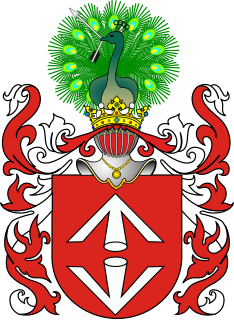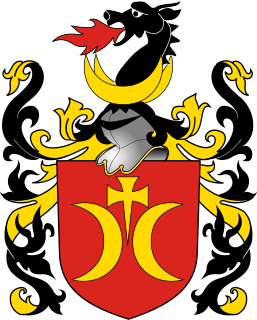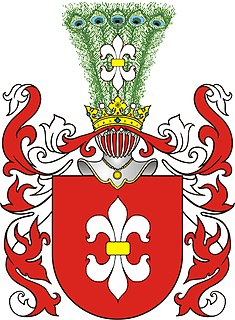
Szaszor, also known as Saszor, is a heraldic charge in the shape of headless eagle. [1] [2]

Szaszor, also known as Saszor, is a heraldic charge in the shape of headless eagle. [1] [2]
It was used in the Orla and Saszow coat of arms of heraldic clans of Poland. [1] It is also used in the coat of arms and flag of the municipality of Rędziny, Silesian Voivodeship, Poland. [3]

Nałęcz is a Polish coat of arms. It was used by associated szlachta families in the Kingdom of Poland and the Polish–Lithuanian Commonwealth (1569–1795).

Leliwa is a Polish coat of arms. It was used by several hundred szlachta families during the existence of the Kingdom of Poland and the Polish–Lithuanian Commonwealth, and remains in use today by many of the descendants of these families. There are several forms of the arms, all of which bear the name, Leliwa, but which may be distinguished as variations of the same arms by the addition of a Roman numeral. In 19th century during a pan South-Slavic Illyrian movement heraldic term Leliwa also entered Croatian heraldry as a name for the coat of arms considered to be the oldest known symbol; Bleu celeste, a mullet of six points Or surmounted above a crescent Argent – A golden six-pointed star over a silver crescent moon on a blue shield, but also as a name for all other coats of arms that have a crescent and a mullet.

Ciołek is a Polish coat of arms, one of the oldest in medieval Poland. It was used by many szlachta (noble) families under the late Piast dynasty, under the Polish–Lithuanian Commonwealth, during the Partitions of Poland, and in the 20th century. The variant names "Siolek" and "Cialek" arose from miscommunication among early-20th-century Polish immigrants to the United States.

Bogoria is a Polish coat of arms. It was used by several szlachta families in medieval Poland and later under the Polish–Lithuanian Commonwealth, branches of the original medieval Bogoriowie family as well as families connected with the Clan by adoption.

Topór is a Polish coat of arms. It was used by several szlachta (noble) families in medieval Poland and under the Polish–Lithuanian Commonwealth.

Ogończyk is a Polish coat of arms. It was used by several szlachta families in the times of the Kingdom of Poland and the Polish–Lithuanian Commonwealth.

Polish heraldry refers to the study of coats of arms in the lands of historical Poland. It focuses on specifically Polish traits of heraldry. The term is also used to refer to the Polish heraldic system, as opposed to systems used elsewhere, notably in Western Europe. As such, it is an integral part of the history of the szlachta, the nobility of Poland.
Bartek is a Polish, Czech and Slovak given name and surname, a diminutive of Bartłomiej. Notable people with this name include:

Ostoja is a Polish coat of arms that probably originated from Sarmatian Tamga and refer to Royal Sarmatians using Draco standard. Following the end of the Roman Empire, in the Middle Ages it was used by Ostoja family in Lesser Poland and later also in Kujavia, Mazowsze and Greater Poland. It is a coat of arms of noble families that fought in the same military unit using battle cry Hostoja or Ostoja, and that applied their ancient heritage on the Coat of Arms, forming a Clan of knights. Later, when the Clan expanded their territory to Pomerania, Prussia, Slovakia, Hungary and Romania they also adopted a few noble families of Ruthenian origin that in 14-15th century settled down in Lithuania, Belarus and Ukraine, finally turning into the Clan of Ostoja. As different lines of the clan formed surnames after their properties and adding the adoptions, Ostoja was also recognized as CoA of several families that was not necessary connected to the original Clan, forming Heraldic clan.

Aleksander Brückner was a Polish scholar of Slavic languages and literatures (Slavistics), philologist, lexicographer and historian of literature. He is among the most notable Slavicists of the late 19th and early 20th centuries, and the first to prepare complete monographs on the history of Polish language and culture. He published more than 1,500 titles and discovered the oldest extant prose text in Polish.
Łan, is an old unit of field measurement used in Poland. Since the 13th century, its value has varied from one location to another. A greater łan consisted of 43.2 morgs = 23 to 28 hectares. A lesser łan was 30 morg ≈ 17,955 hectare.
Słownik etymologiczny języka polskiego is an etymological dictionary first published in 1927. It was compiled by Aleksander Brückner and served through the 20th century as a principal Polish etymological dictionary.

Achinger is a Polish coat of arms. It was used by several szlachta families in the times of the Kingdom of Poland and the Polish–Lithuanian Commonwealth.

Biberstein - is a Polish coat of arms. It was used by several szlachta families in the times of the Kingdom of Poland and the Polish–Lithuanian Commonwealth.

Kur is a Polish coat of arms. It was used by several noble families forming a Clan of Kur in the times of the Kingdom of Poland and the Polish–Lithuanian Commonwealth. It is noted during the reign of the Jagiellon dynasty and illustrated with its original name in the work of Bartosz Paprocki "Herby Rycerstwa Polskiego" in 1584. Furthermore, it is published in the work of Szymon Okolski in 1641. and several other publications

The grzywna was a measure of weight, mainly for silver, commonly used throughout medieval central and eastern Europe, particularly in the Kingdom of Poland and Kingdom of Bohemia.
Wici was a call to arms in the medieval Poland, known from prehistoric times. It was a specific method to spread a warning that the country is in danger, and that warriors should immediately go to the nearest commandant's headquarters, where an army attachment would be formed.

Alfred Znamierowski was a Polish vexillologist, heraldist, illustrator, and journalist. During his career he published several books and designed hundreds of coats of arms, flags, banners and seals for over 200 different municipalities and institutions.

A heraldic clan, in Poland, comprised all the noble (szlachta) bearers of the same coat of arms. The members of a heraldic clan were not necessarily linked by consanguinity. The concept of heraldic clan was unique to Polish heraldry.

Dictionaries of the Polish language are reference works for the Polish language. Earliest dictionaries of the Polish language were bilingual aids, usually Polish–Latin, and date to the 15th century. The first dictionary dedicated solely to the Polish language was published in the early 19th century. Most dictionaries of the Polish language are named simply "the Dictionary of the Polish Language" or in similar fashion.